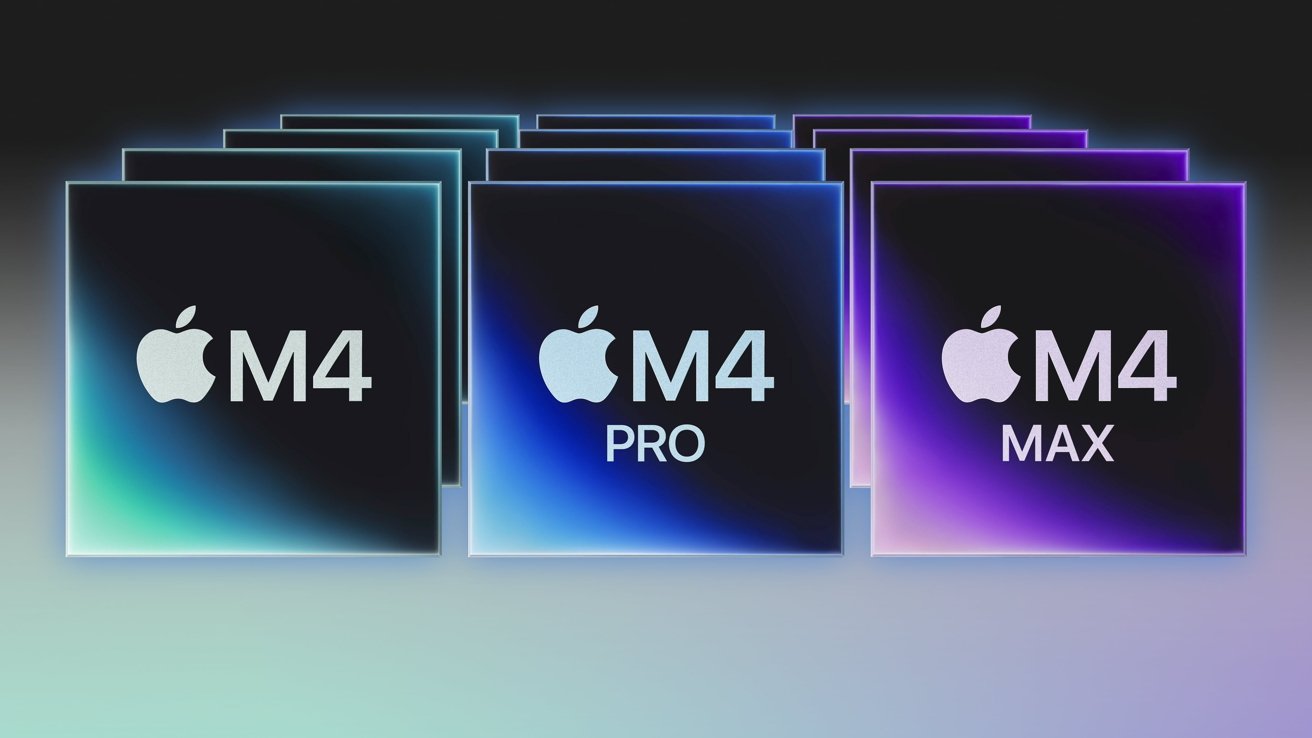Apple Silicon speed has steadily improved since the debut in 2020. Here's how much faster Apple has made its chips in just four years.
Chip generations tend to improve with age. As designs get better and production processes squeeze more onto a smaller space, the performance of chips get better over time.
This is also true of Apple Silicon, Apple's self-designed chips used in its Mac lineup, as well as the iPad Pro and iPad Air. The replacement of Intel's chips has proven itself repeatedly to have been a great move for Apple, with the improvements impressing customers and resulting in more buyers.
Now, as the fourth generation of Apple Silicon ships in the form of the M4 series, we have three generational jumps to analyze. We can see more accurately how Apple's chip lineup has improved since the M1 first launched in November 2020.
Apple Silicon Chip comparisons
When performing this comparison, we are using the Geekbench results listings as our base. Using the latest results eliminates any version changes in the benchmark, so the results should all be on a fair footing.
There are some other issues to consider when using this approach, such as chip releases with core count options. There are also differences between a MacBook Pro and a Mac Studio, for example, which can affect the thermal management and therefore the results.
There are other factors too, including the production process providing improvements with die shrinks, as well as memory bandwidth upgrades.
To save splitting hairs, we are only using the top result for each chip in each category, to give it the highest potential score.
When it comes to the M4, Geekbench's Mac results list doesn't have any figures. However, you can search for the models of Mac in its database and fish out results.
For M4 models, we averaged out figures that seemed plausible, to try and root out any false or heavily errant results.
Single-core changes in Apple Silicon
Of the three benchmark results, the single-core testing offers the least variance between models. This consistency is pretty much down to how Apple produces versions of its chips.
A chip maker like Intel could differentiate between chip variants in a generation by modifying multiple factors, including core clock speeds and the number of cores. Apple tends to keep the clock speeds pretty similar across a generation, but it still has the option to change the core counts.
Each Apple Silicon chip could have different core splits between performance cores and efficiency cores. But since we know the speed of each core type will be pretty comparable, there's not going to be much difference between an M1 and an M1 Max here.
Also, when performing a single-core test in Geekbench, the performance cores are the ones that tend to be used.
When compared by percentage change from the M1 version, we see pretty similar results for each of the base, Pro, and Max chips.
The M2 generation is between 11% and 16% better than the M1 for single-core results. The M3 is between 29% and 20% better, while the M4 is between 63% and 68% better.
For the two Ultra chips, the M2 Ultra is 16% better than the M1 Ultra in single-core testing.
What this comparison shows is that Apple's upgrades are quite consistent across a generation when it comes to single-core comparisons. It also demonstrates that there is a fairly sizable performance boost evident in each generation.
Multi-core changes in Apple Silicon
While single-core was fairly straightforward to understand, things get a bit tougher when it comes to the multi-core scores.
The problem here is that prefix "Multi," in that it means all of the chips on a CPU are put under load. With more cores, a chip can score higher.
However, Apple hasn't been entirely consistent in the way it distributes its performance and efficiency cores.
On the lowest 8-core CPUs, it usually splits them evenly, with four each in use. On a more powerful Max chip, such as the M3 Max, it could have a small collection of four efficiency cores, but then fill out the other 12 spots with performance cores.
The inconsistency comes in with the M3 Pro generation. A 12-core M3 Pro is configured with six efficiency cores and six performance cores.
This is odd, since the 8-core M3 and the 16-core M3 Max both have four efficiency cores and the remainder are performance cores. The even split means the M3 Pro doesn't have as much CPU number-crunching performance in multi-core testing than it normally would.
Examining the figures, the addition of lots of cores makes the differences more pronounced, as a percentage. The M2 generation is generally 16% to 17% better than the M1 in multi-core testing.
For the M3 generation, the M3 is 39% better than the M1 and the M3 Max is 66% better, but the M3 Pro is only 24% better. Again, the M3 Pro is an anomaly for Apple Silicon.
M4 is, again, considerably better, reaching 70% better than M1 for the base level, 84% better for the Pros, and 111% better for the Max chips.
Again, the M2 Ultra is 17% better than the M1 Ultra.
GPU changes in Apple Silicon
When it comes to graphical performance, we turn to the Metal test results in Geekbench. Much like how multi-core performance is based on clock speed and core counts, the GPU performance relies on the same things.
However, the core counts of GPUs can grow by a considerable number, depending on the variant.
For example, the humble base M1 has at most an 8-core GPU, the M1 Pro has a 16-core GPU, the Max has a 32-core version, and the Ultra up to 64 cores.
Likewise, M4 starts with 10 cores for the GPU, rising up to 20 cores at most for the Pro, and a maximum 40-core GPU on the M4 Pro.
Clock speeds and other graphical improvements can also impact results.
Comparing the results against the M1 counterparts, the Geekbench figures say the M2 is 41% better than the M1, the M3 is 45% better, and the M4 is 75% more powerful than the original.
For Pro models, there's a 22% improvement from M1 to M2, but the improvement seemingly dips to 17% for the M3 over the M1. Oddly the M4 Pro's GPU is only 3% better than the M1, at least according to the results.
This seems to be an oddity with Geekbench's results listings at some point, as they should be a lot higher. Since the results are updated regularly, it's possible that these figures could correct themselves within days.
At the Max end, things pretty much return to normal. The M2 Max's GPU is 26% better than the M1 Max, the M3 Max is 35% faster than the M1 Max, and the M4 Max is 69% better.
On the Ultra chips, the M2 Ultra's GPU is 38% better than the M1 Ultra's version.
Consistent improvements
Each time Apple introduces a new generation of Apple Silicon, it's promoted as the best version yet. Faster cores, more cores, and better graphics each year.
It's clear from the Geekbench listings that Apple is keeping up with its promise.
At least, if you ignore the oddities that are the M3 Pro's CPU core split and the Pro model GPU results. The former is explainable as Apple's decision, the latter is more likely to be a results problem rather than an Apple issue.
What is certainly understandable is that Apple is making a considerable improvement in each generation of its chips, regardless of the variant.
We can expect that, when M5 eventually arrives, it will be about 20% better than the current M4 chips. That is, if you base the results against what each chip generation brings versus the previous in these figures.
Apple could go wild and offer something completely different in the next generation. More cores, different performance-efficiency core splits, new GPU ideas, can all make a difference to performance.
It could do that, or it could stick to its more gradual improvements. Either way, whatever comes next should be Apple's best yet. As usual.
 Mike Wuerthele and Malcolm Owen
Mike Wuerthele and Malcolm Owen







-m.jpg)






 Charles Martin
Charles Martin
 Malcolm Owen
Malcolm Owen

 Mike Wuerthele
Mike Wuerthele
 Christine McKee
Christine McKee


 Marko Zivkovic
Marko Zivkovic


-m.jpg)






38 Comments
Exactly why do we need to keep adding more CPU cores when most creative oriented applications would benefit from having more GPU cores?
Would be really interesting to know the degree of binning that Apple uses. Generally the more complex the higher the failure rate but that leaves a chip that could probably operate using fewer CPU/GPU parts resulting in a lower grade chip. Since the chips are tested and sealed with the chip name (M4, M4 Pro, M4 Max, M4 Ultra) on the top we can't tell really what the configuration is other than it will be the maximum advertised chipset. Hence a binned M4 Max could be sold/used as either a MR or M4 Pro.
The costs to develop and produce the chips increase with more CPU/GPU components, BUT there are engineering costs at each level.
What if Apple were to make only two chips instead of four, with binning or may even simply substitution and crippling higher level chips - what would be cost/benefit of doing that. I'm sure Apple/TSMC are doing these calculations on each new chip generation.
If you look at Adobe apps for example, they benefit more from CPU as long as the GPU is at a certain level. Once a user has a mid-range GPU then they don’t need GPU as much as RAM & CPU (and the real-life RAM requirements have decreased with Apple Silicon).
Another example is ZBrush which is purely CPU based. Even most of the time working in other 3D applications the CPU is more imporant as people working in 3D spend more time not-rendering than rendering and the machine can render while you put the kettle on.
It’s gamers and some 3d renderers that use more GPU - but CPU 3D Rendering is more accurate and so CPU rendering (obviously with farms) is the default in hollywood whilst us mortals have to just use what’s available on our budgets - typically a desktop GPU rather than a cloud render. The usual options when thinking only of rendering for games or lower-end 3D rendering are GPU (cheap and fast on PC), or CPU (slower, more accurate and slightly better on Mac generally).
When/if Apple release an M4 Ultra that is twice the performance M4 Max (GPU) it should be equivalent to an Nvidia 4090 and set the cat amongst the pigeons. 2025 could be the start of Apple desktop disruption.